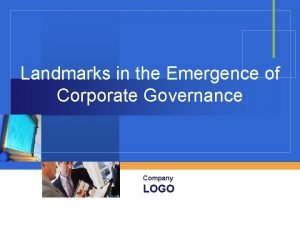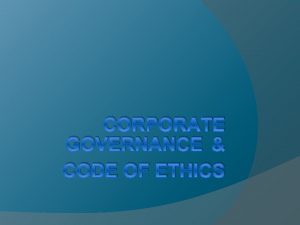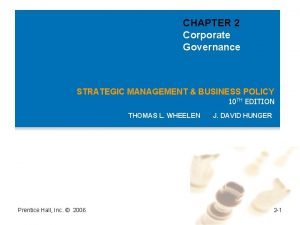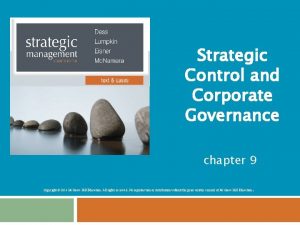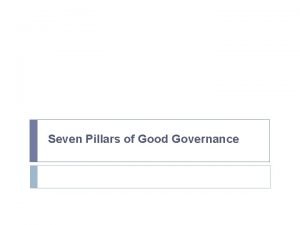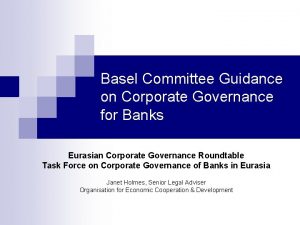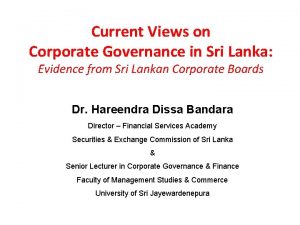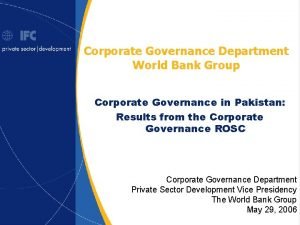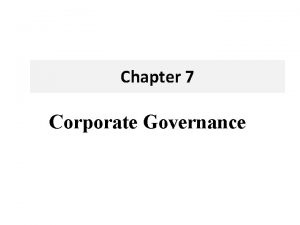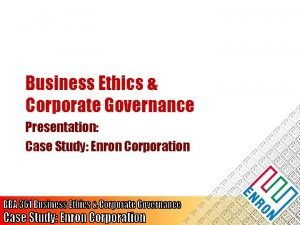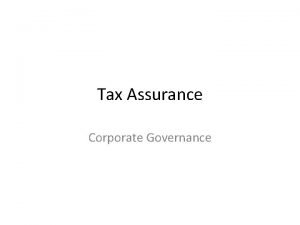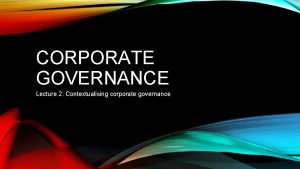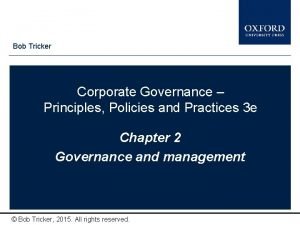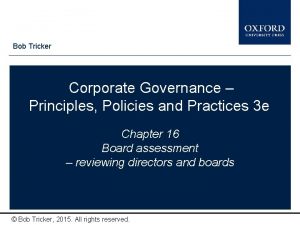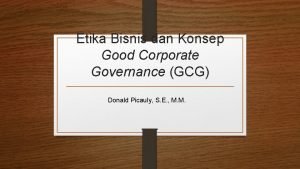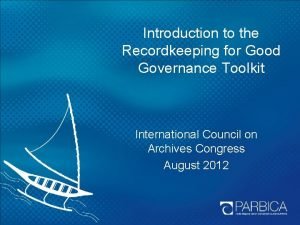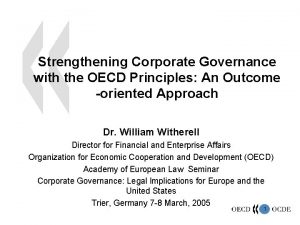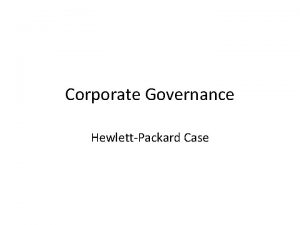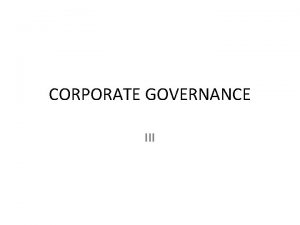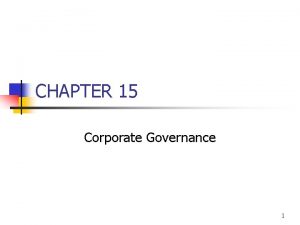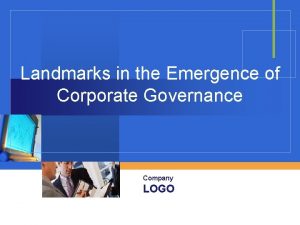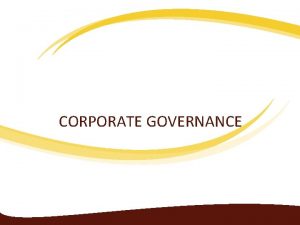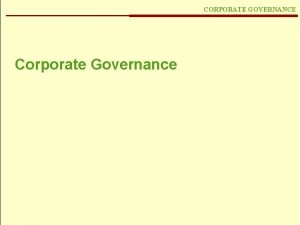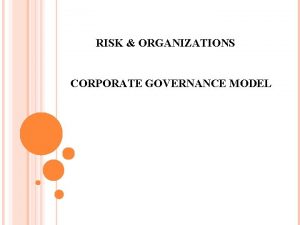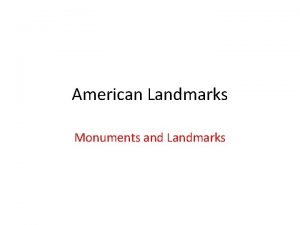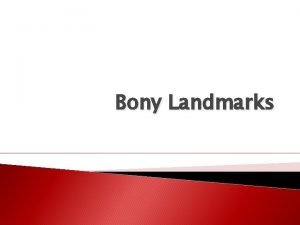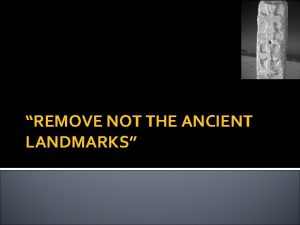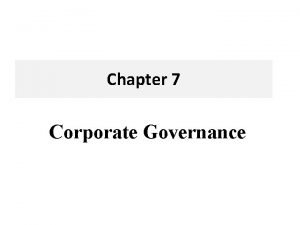Landmarks in the Emergence of Corporate Governance Company







































- Slides: 39

Landmarks in the Emergence of Corporate Governance Company LOGO

Chapter Outline q Introduction q Corporate Governance Committees q World Bank on Corporate Governance q OECD Principals q Sarbanes Oxley Act -2002 q Mckinsey Survey on Corporate Governance q Working Group on Companies Act - 1996

Recent Phenomenon Insistence of mutual funds Change in mind set of people Emergence of Corporate Governance Shareholders Activism From Shareholder focus to stakeholders focus Change inn objectives of Corporation s

Developments in United States v. In United States, Corporate Governance Gained importance with occurrence of Watergate Scandal v. Investigations of scandal highlighted control failures v These failures allowed illegal political contributions by corporations and v. To bribe government officials v. Result was development of Foreign and Corrupt practices Act of 1977

Developments in United States Foreign and Corrupt practices Act of 1977 contained specific provisions regarding: TEXT v. Establishment v. Maintenance and v. Review of system of internal control This was followed by proposal of securities and Exchange commission for mandatory reporting and internal financial control

Developments in United States v. After that there was series of high profile business failures in US v. Tread way Commission v. Objective of commission was to identify main cause misrepresentation of financial reporting v. And to recommend the ways of reducing incidence thereof v Tread way Report published in 1987

Developments in UK v. Seed of Modern Corporate governance in England, were sown by the BCCI scandal TEXT v. BCCI, a global bank TEXT v. Made up of multiplying layers of entities v Related to one another through an impenetrable series holding companies, TEXT affiliate subsidiaries, banks-within-banks, insider dealings, and shareholders relationships

Developments in UK v. At BCCI, there was v. Shoddy record keeping v. Careless regulatory review and audits v. Evasion of ordinary legal restrictions in the movement of capital and goods v. BCCI was a vehicle fundamentally free of government control TEXT v. Ideal mechanism of facilitating illicit activity by others

Development in U. K v. Failure of Barings Bank v. Had financed the Napoleonic wars, Louisiana purchase and Erie Canal v. Failure of bank caused by the single trader, Nick Leeson v. He was posted in Singapore as trader on behalf of Barings Bank v. He was posted in the charge of back office operations of Barings Bank

Developments in UK v. He started trading on the behalf of Bank, whereas he was supposed to trade on the behalf of customers v. Because of earthquake in Japan, his strategy failed v. Barings Bank has already lost $1. 4 billion and had to shut office

Corporate Governance Committees Cadbury committee 1992 The Paul Ruthman committee The Granbury committee 1995 The Hampel Committee The Combined Code 1998

Corporate Governance Committees The Turnbull Committee 1999 World Bank on Corporate Governance OECD Principles Mckinsey Survey on Corporate Governance Sarbanes Oxley Act, 2002

The Cadbury Committee Stated Objective : “ to help raise the standards of corporate governance and level of confidence in financial reporting and auditing, by setting out clearly what it sees as the respective responsibilities of those involved and what it believes is expected of them”

The Cadbury Committee v Investigated the accountability of board of directors to shareholders and society v The Cadbury code of Best Practices had 19 recommendations in the nature of guidelines the board of directors, non-executive directors and such other officials v Submitted Code of Best practices in 1992 v Companies listed on LSE (London stock Exchange) were require to state that whether or not they are following this Code

Code of Best Practices § § § Recommendations related to Board of Directors Regular meetings of Board Clearly accepted division of responsibilities Board must include non-executive directors of sufficient caliber Agreed procedure for directors in furtherance of their duties All directors should have access to advice and services of company secratery

Code of Best Practices Recommendations related to Nonexecutive Directors § They should bring an independent judgment to bear on different issues § The majority should be independent of the management and free from any business or other relationship § Should be appointed for specific term § Re-appointment should not be automatic § Should be selected through a formal process

Code of Best Practices Recommendations related to executive Directors § Service contract should not exceed three years without shareholders approval § Full and clear disclosure of total emoluments of directors § Separate figures should be given for salary and performance related elements § Basis of performance measurement should be explained § executive director’s pay should be recommended by remuneration committee made up of non-executive directors

Code of Best Practices Recommendations related to control and reporting: § Duty of board to present a balanced and understandable assessment of company’s position § Board should ensure an objective and professional relationship with auditors § Audit committee, consisting of at least three nonexecutive directors § Audit committee must have written terms of references

Code of Best Practices Recommendations related to control and reporting: § The director should explain their responsibilities for preparing accounts next to a statement by auditors about their reporting responsibilities § Directors should report on effectiveness of company’s system of internal control, this was most revolutionary and controversial reuirement § Directors should report that business is a going concern with supporting assumptions as necessary

Your Assessment of Cadbury Committee? ? ?

The Paul Ruthman Committee § This committee was constituted later to deal with said controversial point of Cadbury Report § Reporting requirements restricted to internal financial control only against “the effectiveness of company’s system of internal control” § Final report of committee provided extension to responsibilities of directors to all relevant control objectives including business risk assessment and minimizing the risk of fraud

The Greenbury Committee, 1995 § Established by Confederation of British industry § Focus was on determining director’s remuneration and § To prepare a code of such practices for use by limited companies of United Kingdom

The Greenbury Committee, 1995 The Committee: § Aimed to provide an answer to the general concerns about accountability and level of director’s pay § Argued against statutory control for strengthening accountability by proper allocation of responsibility for determining director’s remuneration, proper reporting to shareholders and greater transparency in process

Code of Best Practices It was divided into the following sections: § § Remuneration committee Disclosures Remunerations policy Service Contracts and Compensation

The Hampel Committee-1995 v Established to protect investors an preserve and enhance the standing of companies listed on LSE v Developed further the Cadbury Report Recommended that: § Auditors should not report on internal control privately to the directors § The directors remain and review all(not just financial) controls § Companies that do not already have an internal audit function, should from time to time, review their need for one

The Combined Code-1998 It subsequently was derived from: v Hampel Committee’s final report v Greenbury Report v. The combined code was appended to the listing rules of the LSE v. Compliance of code is mandatory for all listed companies in United Kingdom

The Combined Code-1998 v. This code also require the Board to maintain a sound system of internal control to safeguard shareholder’s investment and company assets v Directors should review effectiveness of group’s system of internal control, including financial, operational, compliance and risk management v. Risk management was of great concern in this code

The Turnbull Committee-1999 v Set up institute of Chartered Accountants in England Wales v Provided guidance to assist companies in implementing the requirements of Combined Code on internal control v recommended that where companies do not have internal audit function, the board should consider the need for carrying out an internal audit internally v Recommended that board of directors confirm the existence of procedures for evaluating key risks

World Bank on Corporate Governance v. One of earliest international organizations to study this issue v. Focuses on principles such as: v transparency v accountability v fairness and v responsibility

The OECD principles v One of the earlier non-government organization to work on and spell out principles and practices that should govern corporate v OECD principles include the following elements: 1. The rights of shareholders 2. Equitable treatment of shareholder 3. Role of shareholders in corporate governance 4. Disclosure and transparency 5. The responsibilities of Board

The OECD principles v. Guidelines provided are somewhat general v. Anglo-American and Continental European System would be quit consistent with them

The Mckinsey Survey on Corporate Governance v. Mckinsey, the international management consultant organization v. Conducted a survey with sample size of 188 companies v. Companies were taken from six emerging markets, India, Malaysia, South Korea, Taiwan, Mexico an Turkey v. The aim was to determine correlation between good Corporate Governance and market valuation of Company

The Mckinsey Survey on Corporate Governance v. The results of survey pointed positive relationship between the two variables v. Good corporate governance increases market value of company by: Ø Increasing financial performance Ø Transparency of dealings Ø Increasing investors confidence

The Mckinsey Survey on Corporate Governance The survey rated the performance on corporate governance of each company on the basis of following parameters: 1. Accountability 2. Disclosure and Transparency 3. Shareholder’s equality

Sarbanes Oxley Act- 2002 v. Codifies certain standards of good corporate governance v. The Act calls for protection of those who have the courage to bring frauds to the attention of those who have to handle the frauds v. It is a sincere attempt to address all the issues related to corporate failures to achieve quality governance and restore investor’s confidence

Sarbanes Oxley Act- 2002 Important Provisions of SOX Act include: q. Establishment of Public Company Accounting Oversight Board q. Audit Committee q. Conflict of interest q. Audit partner rotation q. Improper influence on conduct of audits q. Prohibition of non-audit services

q. CEOs and CFOs required to affirm financials q. Loans to directors q. Attorneys q. Securities Analysts q. Penalties

Your Task!!!!!!! ü Go the website of PICG ü Watch the following videos ü Introduction to CG part II ü Present in form of summary what information revealed to you by these videos about Corporate Governance

 Paul ruthman committee
Paul ruthman committee Objectives of corporate governance
Objectives of corporate governance Driving forces of corporate governance
Driving forces of corporate governance P&g corporate governance
P&g corporate governance Corporate governance strategic management
Corporate governance strategic management Chapter 10 corporate governance
Chapter 10 corporate governance Contemporary approach to strategic control
Contemporary approach to strategic control Four pillars of good governance
Four pillars of good governance Basel committee corporate governance
Basel committee corporate governance Objective of corporate finance
Objective of corporate finance Corporate governance in sri lanka
Corporate governance in sri lanka Kumar mangalam birla committee
Kumar mangalam birla committee Corporate governance definition oecd
Corporate governance definition oecd Agency theory examples
Agency theory examples Latar belakang munculnya good corporate governance
Latar belakang munculnya good corporate governance Ultimate beneficial owner secp
Ultimate beneficial owner secp Corporate governance triangle
Corporate governance triangle What is corporate governance
What is corporate governance Insider and outsider system of corporate governance
Insider and outsider system of corporate governance Enron case study
Enron case study Isu dan riset kontemporer corporate governance
Isu dan riset kontemporer corporate governance Corporate governance is a form of
Corporate governance is a form of Oecd principles of corporate governance
Oecd principles of corporate governance Mbhni hgwpi
Mbhni hgwpi Corporate governance clause 49
Corporate governance clause 49 Corporate governance definizione
Corporate governance definizione Definitie corporate governance
Definitie corporate governance Corporate governance lecture
Corporate governance lecture Scope of corporate governance
Scope of corporate governance Bob tricker corporate governance
Bob tricker corporate governance Etika bisnis dan konsep good corporate governance
Etika bisnis dan konsep good corporate governance Corporate governance in strategic management
Corporate governance in strategic management Global corporate governance forum
Global corporate governance forum Role of remuneration committee in corporate governance ppt
Role of remuneration committee in corporate governance ppt Introduction of corporate governance
Introduction of corporate governance Corporate governance tool kit
Corporate governance tool kit Oecd corporate governance definition
Oecd corporate governance definition Hp corporate governance
Hp corporate governance Scope of corporate governance
Scope of corporate governance Potential problems in corporate governance
Potential problems in corporate governance
